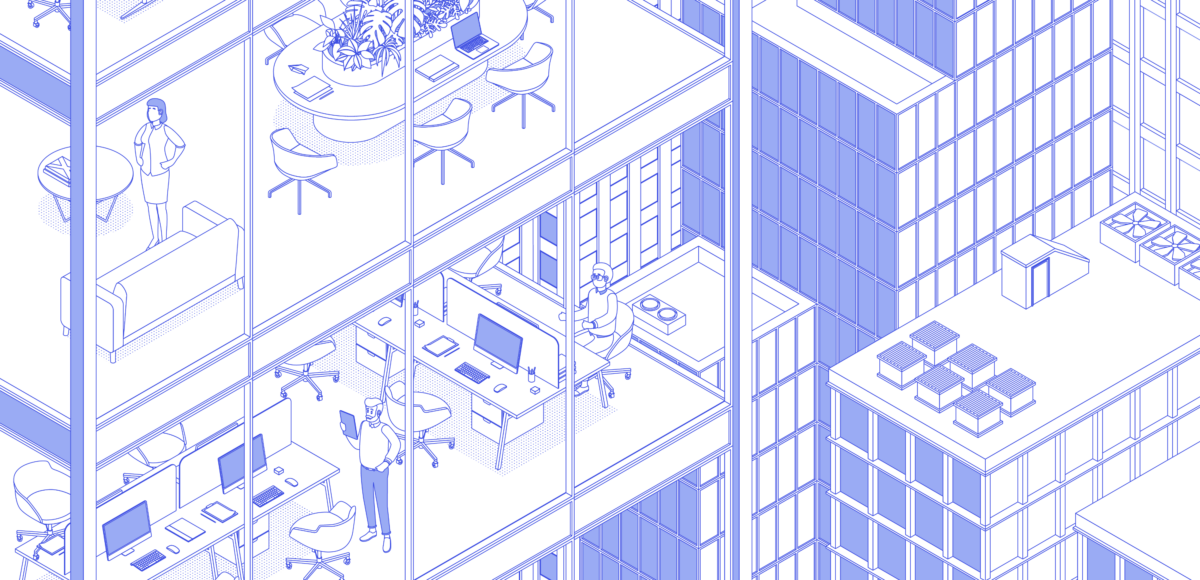For many people, the mere mention of the workplace conjures up a vision of the cubicle farms of yesteryear. Once an up-and-coming office trend, these essential elements of the modern workplace fell out of favor for some time. However, with its ability to provide privacy and a customizable work environment that employees can feel ownership over, the cubicle remains a critical component of the office.
Cubicles don’t just offer privacy, they also provide a physical barrier that can muffle ambient sounds, reduce exposure to germs, and minimize distractions, making them particularly useful for focused work. At the same time, they can inhibit collaboration and potentially block natural light, which can have negative impacts on workers’ physical and mental health.
That’s why many organizations use a mix of cubicles and open spaces. This hybrid approach provides flexibility, allowing employees to have privacy when they want it and a more open, collaborative environment when they need that.
When you reflect on the evolution of the cubicle, one thing becomes clear. They’re here to stay. Like everything else in the office, cubicles continue to evolve to meet workers’ changing needs.
Let’s explore the history and purpose of cubicles, their evolution over time, and how they fit into the future of work.
The Early Days of Cubicles
Cubicles have roots that span centuries. The use of cubicles can be traced to Medieval monasteries, which featured small spaces designed to allow monks to focus while working on manuscripts.
As the Industrial Revolution gave birth to office buildings, the first of which was built in the United Kingdom in 1726, providing individual workspaces remained the design of choice, with offices providing separate rooms for each worker. As offices grew, companies could no longer feasibly provide every employee with their own workspace. By the 1900s, the office looked more like rows and rows of desks in one large room, allowing supervisors to keep an eye on everyone as they worked.
That open layout persisted until the 1960s, when the president of Herman Miller, Robert Propst, took a stand against the current design of the workplace, calling it a wasteland that “saps vitality, blocks talent, and frustrates accomplishment.”
Inspired to institute change, Propst created what’s now known as the Action Office, characterized by modular pieces to create individual workstations. The thinking behind this new design was to provide dedicated areas for various types of work. The original design called for individual spaces for writing, filing, and making calls, with desks that had adjustable heights. After its launch in 1968, the Action Office largely flipped due to high costs and employers’ reluctance to see the value of the investment.
Propst redesigned the original and launched what we now think of as the cubicle. The Action Office II featured cubicles with three partitions to provide each employee with their own private space to complete their tasks.
The Rise of the Cubicle
Although Propst’s design for the Action Office II was intended to provide ample room for each employee with walls of varying heights and options for customizing the space, many companies gravitated to small, boxed-in cubicles with little more than a desk and three walls or dividers. Doing so allowed organizations to fit more people into less space.
When the energy crisis hit in the 1970s and sparked soaring inflation and a spike in the cost of office space, businesses began adopting cubicles to help them use their space in more efficient and cost-effective ways. By fitting more workers into smaller spaces, organizations could maximize productivity while minimizing overhead costs. As a plus, office cubicles allowed them to do so while providing workers with a semblance of privacy. At the same time, the government’s new rules allowing businesses to list furniture as depreciating assets in seven years instead of the 39.5 years for permanent structures like walls enabled companies to recoup their investments faster, making cubicles an even more attractive option.
The Age of the Cube Farm
As cubicles enjoyed widespread adoption, the design strayed further from Propst’s original design allowing for greater customization and space for each worker. Instead, as the concept’s popularity grew and inexpensive versions hit the market, employers crammed more workers into the space by shrinking the cubicle further. By the 1980s and 1990s, cubicle farms became the norm.
By the late 1990s, employees’ disdain for cubicles became evident as mocking media references like the movie, “Office Space,” and the “Dilbert” comic strip rebuked the current way employees were forced to work. What’s more, studies revealed that cubicle farms had a negative impact not only on employee satisfaction, but also their ability to focus, cope with distractions, and maximize productivity.
The backlash didn’t stop there. One study showed that 93% of workers despised cubicles, viewing them as emblematic of a workplace that doesn’t care about its workers. Workers often felt isolated and disconnected from their colleagues, and the lack of variety in workspace design typically led to boredom and decreased motivation.
The Modern Cubicle
The advent of the dot.com boom of the 1990s began disrupting the office’s decades-long status quo. Tech companies and startups rejected the cubicle, favoring open floor plans, comfortable breakout spaces, and luxury amenities. Open office plans became favored in many workplaces, with employers hailing the design’s ability to enhance communication and collaboration. However, the reality soon became clear. Workers in open office plans typically spend less face time with their colleagues and cite privacy issues and noise as productivity-busting disruptions.
COVID-19 changed the way many companies think about office design and the cubicle is once again becoming part of the modern office. Fewer workstations are needed because of hybrid work models. At the same time, social distancing and the awareness of airborne viruses has reframed the benefits of having additional separation between employees.
In the wake of the pandemic, office design trends have also given rise to flexible, mixed-use spaces that combine the best of open floor plans and cubicles. Meeting the needs of the workforce means delivering diverse working conditions, with a combination of open areas for collaboration, smaller rooms for team meetings, and cubicles and other small, private spaces for focused work. To increase engagement, satisfaction, and productivity, the modern workplace offers employees with more choices, including the ability to work in a cubicle when that’s what works best.
Simultaneously, the modern cubicle has continued evolving to meet the needs of today’s workforce and modular workplaces.
The cubicle itself has also undergone a redesign, providing increased flexibility and adaptability with adjustable partitions, modular furniture, and integrated technology. Employee comfort and well-being are a priority in cubicle design, which typically features ergonomic chairs, adjustable lighting, and noise-canceling walls.
One way that CORT Office Furniture Rental supports the modern-day cubicle is by providing modular furniture like our Half Round Training Table, Sit Stand Desk, and Adjustable Stools. These pivotal pieces allow companies the flexibility to reconfigure the layout to meet each employee’s unique needs, an essential element in today’s rapidly changing modular workplace environment. From modular furniture to ergonomic chairs to accessories, CORT has a range of products that help organizations create functional, comfortable workspaces that meet employees’ needs and help support productivity, engagement, and overall satisfaction.
The Future of Cubicles
As workplaces continue to evolve, so will the cubicle. The rise of remote work and flexible schedules has already led to a reimagining of the traditional office space, something that will continue as organizations, employees, and the work world itself evolves. The cubicle will likely continue to adapt parallel to the office, adapting to best meet the needs of the modern workforce and the rising demand for modular workplace solutions.
Flexibility is essential for the modern workplace. Modular workspaces help provide just that, with cubicles providing privacy and noise-dampening capabilities to help boost productivity. This becomes more effective when the design doesn’t take an all-or-nothing approach. Research suggests that cubicles will continue playing an essential role in workplace design, particularly as employees demand more flexibility.
A recent CORT survey revealed that 77% of respondents would consider moving to a furnished apartment within the next year because of the flexibility they offer, a number significantly higher than the 37% who responded similarly in 2022. Although the survey was geared toward housing, the trend isn’t limited only to housing.
Employees crave more autonomy and flexibility in their workplace experience. This flexibility isn’t limited to freelancing, gig work, and remote work. It’s also centered around having broader experiences and opportunities, pursuing goals, and having more choice in when, where, and how they work.
To help businesses achieve balance and flexibility, we offer a variety of desk and seating options. For example, CORT features a selection of Herman Miller workstations that provide privacy for individuals along with a range of multi-functional office tables conducive to group collaboration.
CORT Permanently Flexible™ Solutions can help businesses adapt to the changing needs of the office employees by changing the office design and layout. With the use of CORT’s Permanently Flexible Solutions: 4SITE Technology and CORT Furniture-as-a-Service™, employers can create office layouts that are designed to meet the specific needs of their team — with or without cubicles and individual workstations.
The modern, modular workplace’s design and layout are dependent on the needs of the employees. With 4SITE technology, you can collect vital data about occupancy and usage of different areas of the office that can drive critical decisions about whether the modern-day cubicle would be conducive to the work of your employees.
CORT FaaS allows organizations to continuously update and reconfigure the modular workplace with different furniture options that best fit the needs of the employees in that space.
How Will You Keep Up With the Evolving Office?
Cubicles have come a long way from their earliest use in the 1400s to their inception in office spaces in the 1960s to their use in the modern, modular workplace. Propst’s employee-centered Action Office design gave way to the stark, utilitarian cube farm of the 1980s and 1990s, eventually returning to a more modern, employe-focused cubicle helping businesses meet the evolving needs of the workforce.
Like so many elements of office design, the cubicle’s future is uncertain. However, one thing remains clear: Cubicles are here to stay and will remain an essential component of the modern workplace.
To make the most effective use of cubicles in your own office, turn to the experts. CORT Permanently Flexible Solutions can help you configure optimal layouts, perfect your design, and choose supportive, comfortable furniture to enhance your workplace. Whether you’re incorporating individual workstations to enhance focus and privacy, or outfitting open, collaborative spaces, CORT has a wide range of furniture options and technology to meet the diverse needs of the modern workplace.







